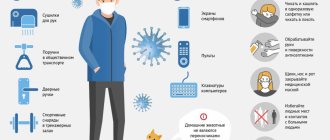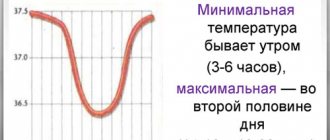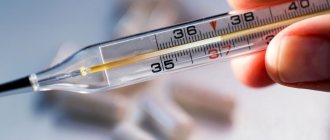Thermoregulation in the body
For normal human life it is necessary that heat exchange be carried out constantly. It depends on the characteristics of the organism and on the presence of various reflex stimuli, and changes can have an effect even if the ambient temperature remains unchanged.
Violation of thermoregulation
First of all, such violations can occur as a result of exposure to external or internal factors. For example, internal diseases include various types of diseases.
The main symptoms can be considered:
- chills;
- chills, as a result of hyperkinesis - when involuntary muscle contractions occur;
- as a result of hypothermia - the consequences of hypothermia;
- as a consequence of hyperthermia - in case of overheating of the body.
The main causes of thermoregulation disorders are:
- congenital or acquired defect of the hypothalamus. It can negatively affect the functioning of many internal organs, including body temperature itself;
- climate change. This external factor is capable of influencing body temperature as a result of adaptation of the body;
- alcohol abuse;
- a consequence of processes associated with aging;
- various mental disorders.
Diagnosis of low-grade fever
Before making a diagnosis, the specialist must examine the patient. The condition of the mucous membranes, the functioning of the respiratory system are studied, and the abdominal organs are palpated.
Defects in joints and lymph nodes are detected. Women undergo a gynecological examination and palpation of the mammary glands, and the menstrual cycle is studied. Anamnesis collection is carried out in several stages.
The doctor determines the following:
- whether there have been surgical interventions or injuries in the recent past (for women - childbirth and abortion);
- what infectious diseases have been suffered during life and whether there are chronic pathologies (particular attention is paid to diabetes, HIV, liver and blood diseases);
- the possibility of hepatitis and bacterial endocarditis.
Such a survey will allow the doctor to get a general idea of the person’s condition. After this, he will measure his body temperature and blood pressure, perform percussion and auscultation.
Usually, already at the examination stage, the specialist notices a rash on the body, a change in the color of the skin, uncharacteristic discharge or formations.
Therefore, to confirm his hypothesis, he prescribes a series of tests showing the state of the blood picture, the possible presence of severe infectious chronic diseases or helminthic infestation.
To do this, the specialist will send the patient for laboratory tests.
To clarify the reason why his temperature is always 37 in the evening, you need to go through:
- clinical and biochemical blood test
- four mandatory tests (HIV, syphilis, hepatitis B and C)
- allergen panel
- general urine analysis
- stool analysis for worm eggs and protozoan cysts
- sputum microscopy
- discharge from the urethra and genitals
- biopsy
- spinal puncture.
The results obtained help identify helminthiasis, inflammatory processes or allergic reactions.
For the purpose of differential diagnosis, it is also necessary to do fluorography, radiography, ultrasound scanning, ECG, EEG, CT, MRI, as well as conduct special targeted studies. All this quickly makes it possible to identify tuberculosis, diseases of the heart, blood vessels, liver and kidneys, malignant neoplasms, which often cause an increase in temperature in the evening.
The specialist receives final confirmation of the diagnosis by conducting instrumental studies. For this purpose, mammography, FGDS, angiography, ultrasonography, etc. are used.
They quite accurately allow you to identify the disease due to which there is a regular rise in temperature, as they show the condition of the patient’s internal organs. In addition, they make it possible to correlate the general picture of the disease with the altered thermal regime.
Increased body temperature
One of the serious signs of pathology in the body is an increase in body temperature. If numbers between 36.5 - 36.9 C are considered normal, then its rise is a signal from the body that an infection or virus has entered it and inflammation has begun. Doctors recommend treating this symptom as:
- the ability of your immune system to begin fighting various irritants;
- about the onset of various disturbances in the normal functioning of internal organs, as well as body tissues.
It is for this reason that it is worth considering the various factors and causes of body temperature fluctuations.
Causes of elevated body temperature
If you have a fever, do not immediately panic and start swallowing pills or calling a doctor. It is worth knowing that some causes of elevated temperature do not pose a danger to humans. Let's look at what you should pay attention to.
Non-dangerous causes include symptoms that will go away on their own:
- if the temperature rise occurs in the evening. Very often, it is at this time that it can rise 0.5-1 degrees above normal;
- as a result of emotional or physical stress. They will increase blood circulation, and with it heat exchange will increase;
- during ovulation in women. Often before the start of the menstrual cycle, hormonal surges are possible, and with this the body temperature rises;
- as a consequence of thermal loads. The presence of a body temperature of 37 and above can manifest itself as a result of eating hot food, visiting a bathhouse or sauna, taking a bath, or after sunbathing.
And now it’s worth talking about the pathological causes that can cause dangerous diseases:
- development of acute or chronic infections;
- various viral diseases, including influenza or ARVI;
- all cases of inflammation or swelling;
- for diseases of the respiratory system;
- if there are disorders of the thyroid gland;
- in case of injury to joints and muscles;
- during the course of a sexually transmitted disease.
Symptoms of elevated body temperature
It is worth saying that a significant increase in temperature will be felt by the person himself. The main symptoms include:
- feeling tired and weak;
- chills appear. Moreover, the greater the heat, the stronger the chill will be;
- the appearance of headache;
- the appearance of body aches. The joints, muscles and fingers are most often affected;
- the person begins to feel cold;
- burning and dry eyes appear;
- the mouth feels dry;
- Appetite may decrease or disappear altogether;
- increased heart rate, arrhythmia may appear;
- sweating increases or, conversely, dry skin.
How and when to bring down a high fever in an adult
Body temperature above 38.5C should be of particular concern. And yet, doctors recommend starting to bring down the temperature with medications when it reaches 38C.
But you should focus, first of all, on your general well-being. If the high temperature is poorly tolerated, unbearable aches, chills, confusion, physical discomfort, vomiting, dizziness are felt, then the temperature should be brought down immediately.
But it also happens that even a high temperature occurs with barely noticeable discomfort, then you should focus on the thermometer mark and, if it exceeds 38.5, take an antipyretic drug.
During fever and throughout the entire period of illness, it is important to drink as much fluid as possible. Through the excretory system, it promotes the rapid elimination of bacteria and viruses and their metabolic products - toxins. As a result, you will recover faster from a high temperature.
If there is a need to bring down the temperature, it is worth adding antipyretic drugs. It is better to give preference to single-component products. Adults are recommended to take paracetamol or ibuprofen based products. The use of multicomponent drugs, where paracetamol or ibuprofen are only part of the composition, should be used in extreme cases. And even more so, exclude the joint use of both.
Reasons for rising temperature
Not always, when the thermometer registers thirty-seven, this only speaks of harmless functional reasons. Often such numbers indicate the development of a disease.
Such jumps may be the first symptom:
- Helminthiasis
- inflammatory process in the body
- introduction of infection
- development of malignant neoplasm
- HIV
- cardiovascular pathology
- allergies
- neurological diseases
- rheumatism
- arthritis
- endocrine diseases
- development of mental pathologies
When an increase in body temperature is recorded in the evening, the reasons can be very different. They may be associated with intoxication by cell breakdown products, the fight against pathogenic microorganisms, or impaired neuromuscular conduction.
It is also possible to become infected with infectious diseases, so consulting a doctor in this case is mandatory.
What not to do at high temperatures
You should react to an elevated temperature without panic, but with special care.
It is not recommended to bring it down in the first minutes after the increase; you need to let the body cope with the temperature on its own. At this time, the body’s defenses are mobilized and pathogens of various diseases die. But even when lowering the temperature, you should not strive for 36.6. In the first days of illness, this is unlikely to be achieved. Rubbing, especially with vinegar or alcohol solutions, is not recommended. However, this practice still exists at home. If a patient with a high fever is pale and his limbs are cold to the touch (so-called white hyperthermia), then any rubbing is contraindicated for him and, in addition to antipyretics, antispasmodics are recommended. The fact is that cold extremities are caused by vasospasm. And in this case, cold rubbing with vinegar or alcohol-containing liquids can only worsen the situation with the blood vessels.
Wiping with vinegar is not indicated for adults and children with respiratory manifestations of the disease or chronic pathologies of the respiratory system. Vapors can worsen the patient's condition and affect the breathing process. Also, intolerance to vinegar or alcohol, as well as the presence of damage and irritation of the skin, are contraindications to rubbing.
At high temperatures, it is not recommended to eat rich, fatty foods and sugar. An increase in glucose levels in the body reduces the number of white blood cells, which are responsible for destroying infected cells. Which can harm the process of fighting bacteria and viruses. And fatty foods create additional stress on digestion and the body devotes some of its energy to this process, instead of fighting the enemy.
Speaking about drinking liquid at a fever, it should be noted that hot drinking is strictly contraindicated! Especially coffee. Caffeine causes dehydration. A hot drink warms up the body even more. Only warm fruit drinks and herbal teas.
Pathological conditions
If a person’s temperature rises to 37 in the evening, this may be an alarm bell. There are many pathological causes for this condition, but they all usually have additional symptoms. Busy people leading an active lifestyle may not even notice them.
Colds
The most common symptom of a cold is an increase in temperature. In this way, the human body tries to cope with the infectious agent. It is known that viruses die when the thermometer reaches 38 degrees. Therefore, you should not lower your temperature to 37. Allow your body to eliminate the infection on its own and build immunity.
Consequences of infection
Many infectious diseases occur with elevated temperature. But what if you are already healthy and it still continues to rise? This outcome is also possible. It is in the evening that the thermometer increases noticeably.
Such symptoms are especially common due to chickenpox, acute intestinal infection, and bacterial pathologies. Don't worry, your body will regain its strength in the near future. Such temperature indicators do not require the use of antipyretics. After a night's rest, they return to normal on their own.
Arterial pressure
Hypertensive patients often complain that they have an elevated body temperature. Such a natural consequence of high blood pressure cannot be called natural, but it is not entirely correct to consider it pathological. As soon as the patient brings the blood pressure back to normal, the thermometer shows lower numbers.
Hypotonics, on the contrary, have a low body temperature. For some people it drops to 36 degrees. It is very important not to miss the moment. But if this condition does not cause discomfort, then there is no need to try to correct it.
You will also be interested in:
- Temperature 37-38 and low pressure - causes and treatment
VSD
This abbreviation stands for vegetative-vascular dystonia. Until now, this disease remains incompletely studied.
Many doctors refute it, saying that the person is dealing with chronic fatigue syndrome. One way or another, with vegetative-vascular dystonia, the thermometer readings increase. A person may note that in the morning the temperature is 36, in the evening – 37.
Oncological pathologies
It is the evening increase in thermometer values that often forces a person to turn to specialists. During the examination, tumor processes may be detected.
Benign neoplasms often do not make themselves felt with such symptoms. But the proliferation of cancer cells affects the lymphatic system, so a slight increase in the readings of the mercury meter is the first alarm bell.
Immune diseases
Any deviations in the functioning of the immune system and protective functions of the body affect temperature values. They become higher with the following pathologies:
- allergy;
- rheumatic diseases;
- blood pathologies;
- system deviations.
Many diseases develop due to increased immune function of the body, which provokes inflammation of various types.
Reduced body temperature
Like high temperatures, low temperatures also indicate problems. Especially if it lasts for a long time. This leads to rapid fatigue, loss of mood, weakness of the body, etc.
Causes of low body temperature
A decrease in temperature is observed:
- with low hemoglobin;
- in case of internal bleeding;
- during pregnancy;
- if there are problems with blood vessels;
- for diabetes;
- with pathology of the adrenal glands;
- during brain tumors;
- with asthenic syndrome;
- during skin lesions;
- as a result of seasonal ARVI;
- in case of intoxication;
- as a consequence of hypothermia;
- with hypothermia.
Symptoms of low body temperature
Symptoms include:
- weakness;
- drowsiness;
- apathy;
- chills;
- feeling of cold.
What is low-grade fever, and how to deal with it?
Low-grade fever is an unreasonable increase in the temperature of the human body. In such cases, the readings do not exceed 37.5 degrees.
The temperature lasts for months or even years. This distinguishes it from the course of acute pathological diseases or physiological causes of increase.
The main sign of low-grade fever is that a person has an elevated body temperature. This disease accompanies:
- increased fatigue;
- drowsiness and weakness;
- decreased appetite;
- redness of the skin;
- disorders of the digestive system;
- increased sweating;
- rapid pulse;
- neuroses and insomnia.
Both a specialist and the patient himself can pre-diagnose the problem. But with low-grade fever, additional research is necessary. To do this, consult a doctor and find out why the temperature rises to 37 in the evening.










